For many, the courses that host PGA Tour events in the winter and spring comprise their bucket lists of dream golf trips. You’re very familiar with the TPC Scottsdale and TPC Sawgrass courses, so you have an easy base to build your trip around. But when it comes time to planning a trip around these tour stops, the question becomes: Where else should we play?
In partnership with our friends at Golfbreaks by PGA TOUR, we sought to assemble itineraries featuring the best golf near each of the winter and spring PGA Tour stops listed below. (Note: We kept this to PGA Tour events in the winter and spring, so other great spring destinations like Sea Island didn't make this list.) We hope the below offers some help in planning that next golf trip.
Here are some of our favorite itineraries:

Does the exhilarating risk-reward finish at TPC Scottsdale’s Stadium Course—home of the WM Phoenix Open—have you planning Scottsdale as your next golf trip destination? We don’t blame you, and with over 200 courses in the area, there’s no shortage of good golf.
Many travelers to Scottsdale will try to add the Stadium Course to their itineraries—and for good reason. Even after the WMPO is complete, the facility leaves up the giant grandstands surrounding the par-3 16th, so public golfers can get a taste of the experience—minus the 20,000 rowdy fans. The Stadium Course features challenging greens throughout and culminates with a memorable finishing stretch, including the par-3 16th (minus the 20,000 rowdy fans).

TPC Scottsdale’s Champions Course, with its pine tree-lined fairways meandering through natural ravines, is also worth playing. The course opened in 2007 and balances playability with strategy, making it an enjoyable experience for golfers of all skill levels.
Both courses at Troon North rank inside the top 10 of Golf Digest’s best public courses in Arizona and were recently renovated by original designer Tom Weiskopf. A former member of our America’s 100 Greatest list, the Monument Course (below) features generous fairways guarded by protruding boulders—none more so than the giant rock formation that sits in the middle of the third fairway, forcing players to pick a side. Much like its sibling course, the Pinnacle Course offers wide, rolling fairways but small greens. Stray from the fairway and you’ll find yourself in a sea of granite boulders.

Continuing the trend of quality 36-hole facilities, head a few miles south from Troon North to Grayhawk Golf Club, where you’ll find two courses ranked inside Golf Digest’s best public tracks in state. The Talon Course (below) not only features views of the McDowell Mountains and the Scottsdale skyline, but it has been described by one of our panelists as one of the “most exciting and dramatic” layouts in the southwest. The back nine plays around deep box canyons with steep drop-offs before culminating in a Dye-esque island-green 17th.

The 8th hole of The Talon Course at Grayhawk Golf Club.
Courtesy of Grayhawk
Grayhawk’s Raptor Course offers a true championship test, as it hosted what is now the Fortinet Championship on the PGA Tour from 2007-2009. While the fairways are wide, deep greenside bunkers and crowned greens will test your short game.
We-Ko-Pa Golf Club, located east of Scottsdale in the Sonoran Desert, offers a natural desert-golf experience devoid of any homes on the courses. The Bill Coore and Ben Crenshaw-designed Saguaro Course (below) is Golf Digest’s top-ranked public course closest to Scottsdale. Built on a relatively flat piece of land with wide fairways throughout, it’s an enjoyable player-friendly walking course.

Lonna Tucker
Also ranked inside our top 10 public courses in the state, the Cholla Course features narrower fairways than the Saguaro, but offers the same stunning views of the surrounding desert and mountains. Meandering through ridges and arroyos, the Cholla Course offers a true desert-golf experience.
Just 10 minutes from We-Ko-Pa, SunRidge Canyon Golf Club features a challenging closing six-hole stretch known as the “Wicked Six.” Sod-faced pot bunkers were recently added throughout, bringing to life the links-style nature of the course, where you can use the ground to filter your ball into the fairways and greens.
Interested in booking one of these trips? Click here to start pricing out your trip with our friends at Golfbreaks by PGA TOUR, or call them: (+1) 843.779.7134.

Joann Dost
Pebble Beach is perhaps golf’s most bucket-list destination. Any public golfer aspires to drive down 17 Mile Drive with a tee time in hand. Though pricier than most destinations on this list, we’re here to help you plan a trip to the Monterey area.
Of course, there’s Pebble—perhaps the greatest meeting of land and sea. The 1919 design by Jack Neville and Douglas Grant has been No. 1 on Golf Digest’s ranking of America’s best public courses since the inception of our public list in 2000. Walking Pebble Beach is to share the sacred ground of all the game’s most iconic champions. The total redesign of Pebble’s short course by Tiger Woods, The Hay, is also a must-play.
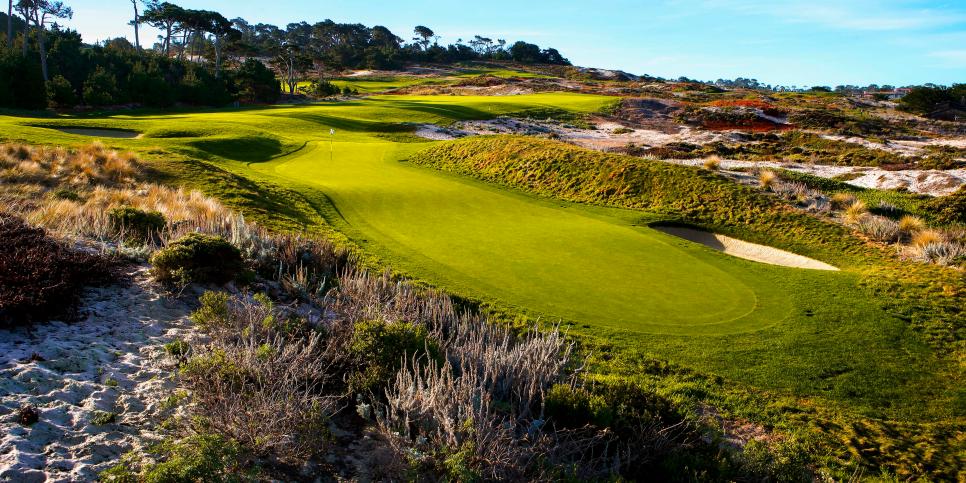
Evan Schiller
On everyone’s bucket list, too, are the resort’s other two stellar options, Spyglass Hill and Spanish Bay. Spyglass Hill, also in the top 10 of our public ranking, is one of the three courses in the rotation of the AT&T Pebble Beach Pro-Am. Weaving through the majestic Monterey pines through the middle of the round, and the giant sand dunes on the first five holes, Spyglass Hill—ranked No. 51 on our latest ranking of America’s 100 Greatest—might be Robert Trent Jones Jr.’s best work. The Links at Spanish Bay, which is also ranked among Golf Digest’s 100 Greatest Courses, opened in 1987 after years of mining out an old sand quarry to shape the land on this coastal links. One of the best post-golf spots is the patio outside Spanish Bay, where bagpipers entertain guests each night. Del Monte Forest, which is also connected to the resort, comes at a more affordable price tag ($110) and offers history, too—it’s the oldest continuously running course west of the Mississippi River.

Northern California Golf Association
Of course, there is much more golf to be played within the area—much of it at a cheaper price tag than Pebble’s courses. Poppy Hills won’t necessarily make a list of the most affordable courses in the country, but in this zip code, it’s somewhere all Pebble goers should try to play. An extensive redesign by Bruce Charlton and Robert Trent Jones II in 2013 brought back sandy, naturalized areas in an effort to be a low-profile layout.

Andy Johnson/The Fried Egg
In terms of affordability, Pacific Grove (above)—or the poor man’s Pebble Beach, as it’s been known— is impossible to beat in the area. With holes along the water in addition to some really fun shorter holes, it’s one of the best value courses in the country.

Courtesy of GolfBreaks
Just five miles inland from Carmel Beach is Carmel Valley Ranch, Pete Dye’s only design in Northern California. With artistically designed bunkers and risk-reward holes with water in play, Carmel Valley Ranch is worth playing.
Finally, the Bayonet and Blackhorse courses are two mainstays and enjoyable courses to add onto your trip. The 36-hole facility was built on an old Army training site with some idyllic views of the Pacific Ocean.
Interested in booking one of these trips? Click here to start pricing out your trip with our friends at Golfbreaks by PGA TOUR, or call them: (+1) 843.779.7134.
Tucked between Savannah, Ga., and Charleston, S.C., Hilton Head Island is an easy-to-get-to destination packed with great golf. It’s only 12 miles long, making it one of the most densely packed areas for stellar golf this side of the Atlantic.
The Sea Pines Resort was the first, and, to some, still the best resort on the island. Located near the southern tip of the island, a five-star boutique hotel or self-catering villas await guests staying at the resort. There are three golf courses on the property, two designed by Pete Dye.

Golf fans will recognize Harbour Town Golf Links (above), No. 25 on Golf Digest’s America’s 100 Greatest Public Courses, for the red-and-white-striped lighthouse behind the 18th green they see every year at the RBC Heritage the week after the Masters. The first 16 holes play inland before 17 and 18 emerge with views of Calibogue Sound. Accuracy is at a premium here as small greens punctuate holes with narrow, tree-lined fairways.
Atlantic Dunes is a complete rebuild of the historic Ocean Course, the first course built on Hilton Head. Davis Love III and his team redesigned it again in 2016, making use of natural sand dunes and indigenous plants. The par-3 15th is one of only two holes on the entire island to border the Atlantic Ocean.

Heron Point, the second Pete Dye design at the resort, is a bit more player-friendly than other Dye designs on the island. It plays more inland, offering more of a lowcountry feel and a bit less wind to contend with. Do not be fooled, rolling fairways and strategically placed bunkers still present a challenge.
Right at the midpoint of the island, on the east coast, Palmetto Dunes Resort similarly offers three of the best public options in Hilton Head, each named for its architect.
The Robert Trent Jones course is home to the second hole that borders the Atlantic as the par-5 10th points players straight to the sea. Water is ever-present on this loop, with 11 holes playing around a lagoon.
The George Fazio course is regarded as one of the hardest public courses on Hilton Head Island. Another parkland style course, narrow fairways and small greens protect this course from low scores, as do four long par threes and only two par fives.
The Arthur Hills course has hosted the likes of Tiger Woods and Phil Mickelson for tournaments during their college careers. It’s also home to the Historic Leamington Lighthouse, situated right behind the 15th green. Built in the late 1800s, this structure was part of a larger system of lights that would help guide ships into Port Royal Sound.
Interested in booking one of these trips? Click here to start pricing out your trip with our friends at Golfbreaks by PGA TOUR, or call them: (+1) 843.779.7134.
Texas is certainly a great state for golf, but when it comes to public courses, it doesn’t necessarily have a standout resort destination (though that might change with the Omni PGA Frisco development). It does have a collection of very good public options, and TPC San Antonio—where the Valero Texas Open takes place—is worth building a trip around.

The Oaks course, where the tournament is played, is Golf Digest’s top-ranked public course in the state. The Greg Norman design (with an assist from Sergio Garcia) tips out at 7,435 yards and incorporates some rocky terrain and native grasses nicely in the routing. The facility’s Canyons course, which hosted a PGA Tour Champions event from 2011-15 views, ranks inside our top-15 public courses in Texas. The Pete Dye design offers views of a 700-acre nature preserve.
.jpg.rend.hgtvcom.966.644.suffix/1644375785322.jpeg)
Those building a golf trip in San Antonio can add some other very good public tracks. The Quarry Golf Course (above) is a Keith Foster design that utilizes rock formations that were part of the old Alamo Quarry that date back to 1908. La Cantera Resort & Spa (Resort) was named Golf Digest’s Best New Public Course of 1995 and features thrilling elevation changes. And Brackenridge Park, or “Brack” to the locals, is an A.W. Tillinghast original design that dates back to 1916. It hosted the inaugural Texas Open in 1922—and following a restoration in the late 2000s—boasts one of the best values in Texas at tee times starting under $60.
Of course, Austin is just about an hour and a half away, and offers plenty for those looking to extend their San Antonio golf trips. Horseshoe Bay Resort and its three public 18-hole courses (plus the private Summit Rock) should be on every golfer’s radar (it’s about an hour from Austin and an hour and a half from San Antonio).

Ram Rock is the second-highest ranked public course in Texas, and the demanding test has hosted the Texas Open on multiple occasions. The island-green par-3 fourth hole is a standout. The resort’s Apple Rock and Slick Rock are also Robert Trent Jones Sr. layouts and worth playing.
Interested in booking one of these trips? Click here to start pricing out your trip with our friends at Golfbreaks by PGA TOUR, or call them: (+1) 843.779.7134.
This is an ideal time of year to be in Palm Springs. Golf courses are in their peak shape in the winter and the weather is tough to beat.

Of course, PGA West is tops on any list of public destinations in the desert. The Stadium Course hosts the annual PGA Tour event and is known for its risk-reward challenges, plus the massive 18-foot high bunker on the par-5 16th hole as well as the island-green 17th hole. The Pete Dye design is one of three courses at the facility, in addition to the Pete Dye Mountain course and the Dunes course. Greg Norman and Jack Nicklaus also each designed courses that bear their names—the Nicklaus Tournament course is part of the annual rotation of courses for the tour event.

Courtesy of GolfBreaks
So where else should you play besides the courses at the La Quinta/PGA West resort? The Classic Club (above) should be near the top of your list. The Arnold Palmer-designed layout used to be in the rotation for the Bob Hope tour event. Water plays on 14 of the 18 holes, and many holes have fairways that slope toward the water hazards, so driving the ball is at a premium. The facilities are top-notch at this Troon-managed club—including a 63,000-square foot, three-floor Tuscan-inspired clubhouse.
Another top-notch option is the Westin Rancho Mirage Golf Resort & Spa. The Pete Dye resort course isn’t particularly long, tipping out at just under 7,000 yards, but features Dye’s signature railroad ties, pot bunkers, elevated tees and hidden pin positions. Mission Hills North, the only Gary Player design in the Palm Springs area, contains five sets of tees, making the course enjoyable for players of any skill level.

Courtesy of GolfBreaks
SilverRock Golf Resort (above) co-hosted the Bob Hope Classic from 2008-11 after it opened 2005. Set in the Santa Rosa Mountains, this Arnold Palmer design features incredible vistas, tight fairways, fast greens and challenging water hazards. Particularly for competitive golfers, this is a great test.

One of the most underrated courses in the desert is the Firecliff course at Desert Willow (above). Dr. Michael Hurdzan and Dana Fry designed 36 holes (including the Mountain course) on this flat desert floor in the Coachella Valley and moved enough earth to create some interesting holes that frame the surrounding mountains. Playability for all handicap ranges is strong, but even for the better players, the Firecliff course is an intriguing and fair test.
Interested in booking one of these trips? Click here to start pricing out your trip with our friends at Golfbreaks by PGA TOUR, or call them: (+1) 843.779.7134.
The Jacksonville area has long been home to exceptional golf. Extending down the coast to Ponte Vedra Beach and St. Augustine, there’s no shortage of stay-and-play options.

Dom Furore / Golf Digest
TPC Sawgrass is home to one of the most recognizable par 3s in the world, the 17th at the Stadium Course. The Players takes place here every spring with hundreds of balls finding the water over the course of the week, even though it’s just a pitching wedge for most pros.

Its sister course, Dye’s Valley (above) is another must-play. Maintained to the same standard as the Stadium Course, but less difficult, this is either the perfect warm-up test or cool down from a date with the devil across the property.
Anyone who’s watched more than a few hours of golf in their life, especially on Thursday and Friday, has seen the commercial with Gary Player advertising the World Golf Village. Joking aside, this is a worthy destination for any golfer in the area. The King & Bear is the only course in the world co-designed by Jack Nicklaus, aka The Golden Bear, and Arnold Palmer, The King. Though it’s the product of two of the best golfers of all time, the course is lauded for its playability—but your short game must be in good shape in order to post a good score.

Dave Sansom
The Slammer & Squire (above) was designed by Bobby Weed, with consulting from Sam “The Slammer” Snead and Gene “The Squire” Sarazen. Opened in 1998, this gem is known for its unique par 3 and wide, tumbling fairways typical of resort golf.
Down the road in St. Augustine, St. John’s Golf & Country Club is located in an Audubon Sanctuary, meaning players are surrounded by wildlife. Depending on the wind coming off the Atlantic Ocean, St. John’s could provide a stern test or yield lots of birdies.

Courtesy of the club
Jacksonville Beach Golf Club, a lovable muny just a few blocks from the beach (above), is worth adding onto any Jacksonville-area trip. It was redone in 2018 to boost playability and fun, making it perfect for a casual round.
Interested in booking one of these trips? Click here to start pricing out your trip with our friends at Golfbreaks by PGA TOUR, or call them: (+1) 843.779.7134.
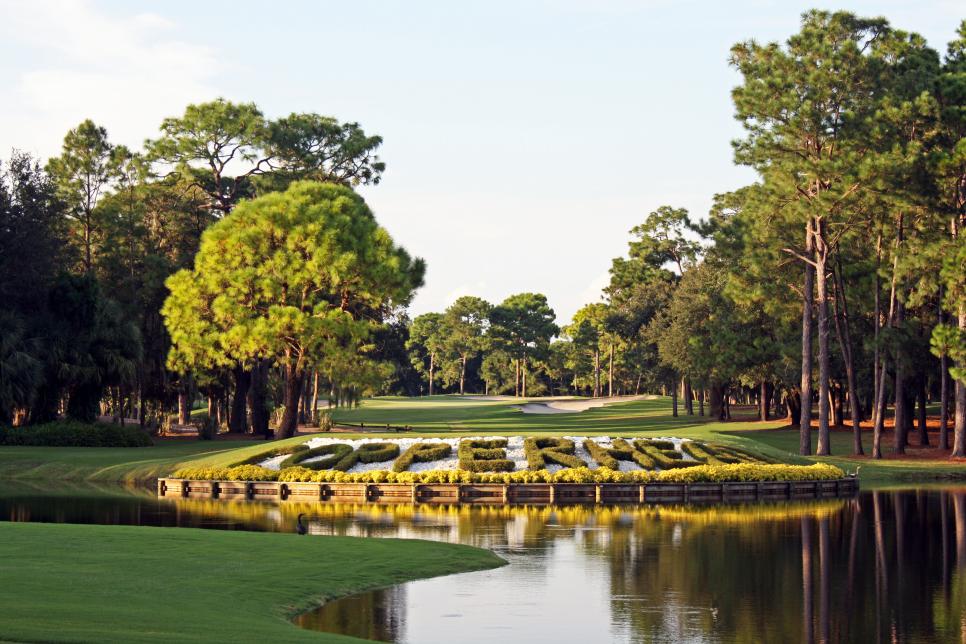
Innisbrook’s Copperhead course, the host of the Valspar Championship, with its tight, tree-lined fairways and rolling terrain—offers a unique taste of Florida golf that makes it a worthwhile layout to play in Tampa.
The course is a tough ball-striking challenge with a demanding three-hole finish—known as the Snake Pit—that often makes for dramatic finishes to the annual PGA Tour stop.
The Island Course at Innisbrook, with its dramatic elevation changes and undulating greens, is a must-play on a visit to the resort. Much like the Copperhead, the Island Course defends itself with tight fairways, imposing lakes, and significant elevation changes.
Just north of Tampa, Saddlebrook Resort’s Palmer Course resembles a New England layout with its rolling fairways and small greens. This Arnold Palmer-design is generally forgiving off the tee, but requires precise approach play from uneven lies to undulating greens. Arnold Palmer also designed the Saddlebrook Course at the resort, which is tighter off the tee, with fairways guarded by water and trees. Water comes into play on 14 of the 18 holes, placing a premium on accuracy.

LC Lambrecht
A little over an hour southeast of Tampa, Streamsong Resort is well worth the drive, being the only facility with three courses on our Second 100 Greatest list. Coore and Crenshaw’s masterpiece at Streamsong Red—with its towering sand dunes and open savannah—presents a beautifully natural setting. The firm and bouncy turf allows you to play the many links holes on the ground or through the air.
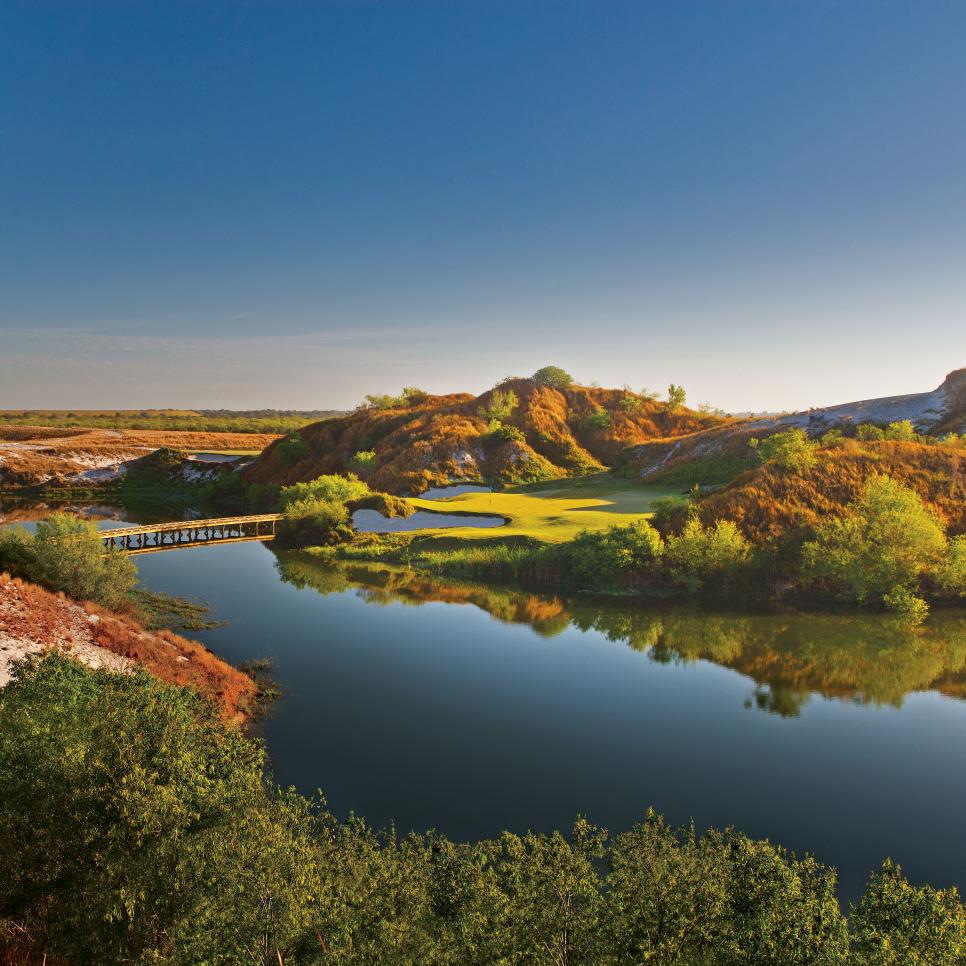
Laurence Lambrecht
Streamsong Blue, designed by Tom Doak, begins with a dramatic 75-foot drop from the back tee at the first hole to the fairway, a fitting beginning to a course characterized by elevation changes. The Blue Course offers a complex, undulating set of greens, some with massive shelves and valleys.
.jpg.rend.hgtvcom.966.544.suffix/1644519945505.jpeg)
LC Lambrecht
Streamsong Black, designed by Gil Hanse, features some of the largest green complexes on this continent. With strategic thinking required throughout, there are endless shot options at this true links course, leaving several of our panelists wanting to play many of the holes again to try new tactics.
On your visit to Tampa, make sure to visit TPC Tampa Bay, which offers a wide variety of holes with lakes and natural wetlands in play. While the fairways are wide and relatively flat, the greens are large and undulating, placing a premium on a strong short game.
Interested in booking one of these trips? Click here to start pricing out your trip with our friends at Golfbreaks by PGA TOUR, or call them: (+1) 843.779.7134.
San Diego has long been a vacation destination in the United States. And while much of the rest of the country is enduring the cold and snow of winter, the weather in Southern California is, well, the same as it always is: warm and sunny.
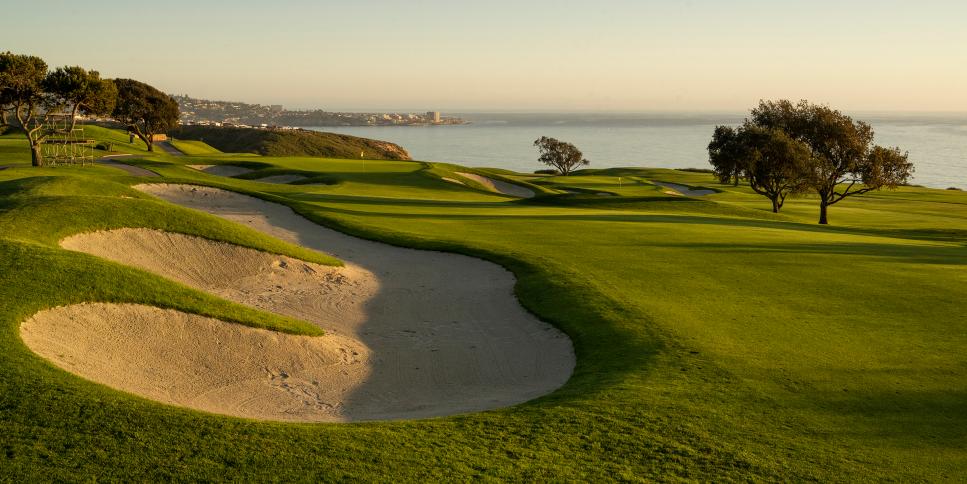
J.D. Cuban
Torrey Pines hosts annually the Farmers Insurance Open and, every now and then, a U.S. Open. For the PGA Tour stop, both the North (below) and South courses are in play, while for the U.S. Open, only the South is played as the North is transformed into a staging area for hospitality tents and parking. This past year, the grounds crew had only seven months between the 2021 U.S. Open and the Farmers this January. At No. 42 on Golf Digest’s America’s 100 Greatest Public Courses, the South Course is home to eight of Tiger Woods’s career wins on the PGA Tour, including the 2008 U.S. Open, his 14th of 15 major victories.
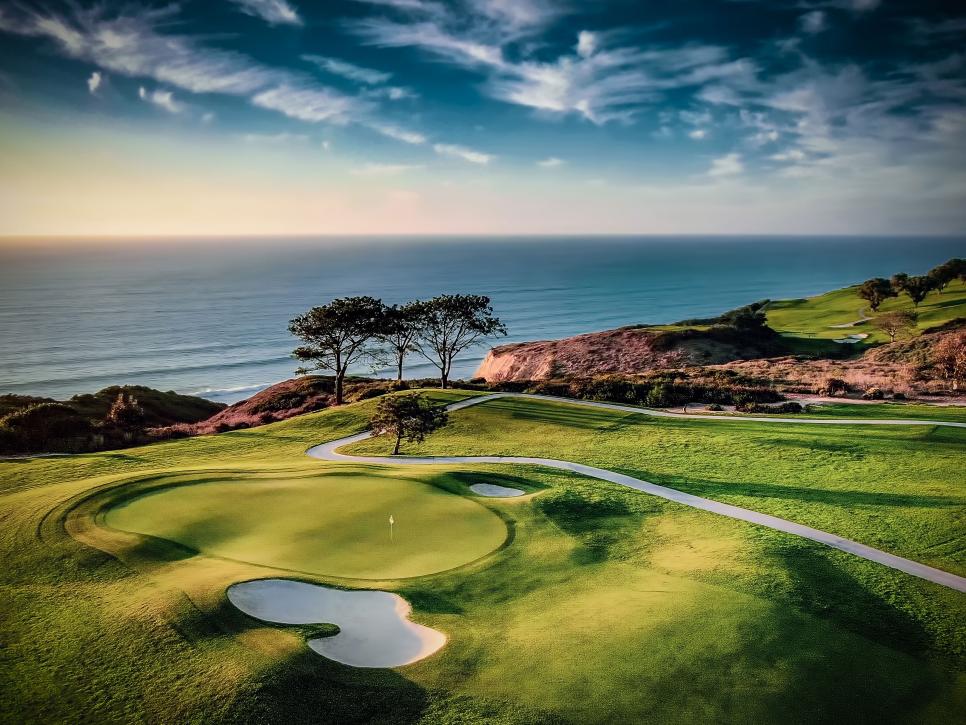
Mark Degnan
Set 30 miles north of San Diego, the Omni La Costa Resort is an ideal place for a stay-and-play trip. With two on-site courses, in addition to a number of tennis courts, pools with water slides, a full-service spa and a handful of restaurants, this place has something for everyone in the family.
A composite of the Legends and Champions Courses was home to two PGA Tour events from 1969 to the mid 2000s. The Mercedes Championships, now the Sentry Tournament of Champions in Hawaii, was played here from 1969 to 1998. In 1999, the venue was awarded the inaugural WGC-Accenture Match Play, now the WGC-Dell Match Play in Austin, Texas. In 2010 and 2012, La Costa hosted the LPGA’s Kia Classic.
The Kia Classic is now the JTBC Classic and has moved not 10 minutes up the road to Aviara Golf Club at the Park Hyatt Resort. Arnold Palmer designed this 18-hole beauty, while the resort that runs it boasts three restaurants: Vivace, an Italian spot, California Bistro, a breakfast and lunch option, and the Argyle Steakhouse.
Interested in booking one of these trips? Click here to start pricing out your trip with our friends at Golfbreaks by PGA TOUR, or call them: (+1) 843.779.7134.
Just as the PGA Tour kicks off its Florida Swing at The Honda Classic, you might consider starting your southeast Florida golf trip at PGA National’s Champion Course (below). Routinely one of the toughest courses on tour, The Champion is home to The Bear Trap—the demanding three-hole stretch (Nos. 15-17) that requires precision iron play. With wind often playing a factor and water lurking on many holes, The Champion is a true ball-striking test.

PGA National also has two new courses designed by Andy Staples, the 18-hole Match course and the nine-hole Staple course.
Perhaps the most forgiving course at PGA National, The Palmer Course offers wide fairways and relatively flat greens. This Arnold Palmer-design features plenty of risk-reward opportunities, including at the par-5 18th, making the course entertaining for players of all skill levels.
The Fazio Course, formerly The Haig, was PGA National’s original course that opened in 1980. Recent renovations have expanded the size of the greens, increasing the playability of the layout that features a variety of holes, including doglegs in each direction.
Before leaving PGA National, make sure to stop by The Estate Course, located five miles west of the main resort. One of the shorter courses at PGA National, The Estate offers generous fairways and large greens, making it an enjoyable round for all.

Stephen Szurlej
After finishing at PGA National, head down I-95 to another notable collection of courses at Trump National Doral Miami. The Blue Monster, which hosted a PGA Tour event for more than 50 years, is currently inside our top five public courses in the state. Restored by Gil Hanse in 2014, the Blue Monster features strategically placed bunkers and water in play on 11 of the 18 holes, including the par-4 18th, which often played as one of the toughest holes on tour.
One of the shorter courses at Trump National Doral, the Red Tiger Course offers an exciting variety of holes, with six par 3s, six par 4s and six par 5s. Resembling a New England-style course, the greens are relatively small, requiring precise approach play. The Silver Fox Course, with its narrow fairways and water in play on 17 of the 18 holes, provides a stern test of ball-striking ability. The par-3 seventh features an island green with elevated tees. The Golden Palm Course presents a variety of holes, with some being wide and inviting and others tight and tree-lined. The greens are undulating throughout, requiring a deft touch to score well.
Located just eight miles south of the Fort Lauderdale airport, JW Marriott Miami Turnberry Resort and Spa is the perfect place to wrap up your trip. The resort’s Soffer Course features relatively narrow landing areas guarded by meandering creeks. The course is picturesque, with railroad-tie lined fairways and an island-green 18th hole, set beside a cascading waterfall. The Miller Course is the shorter of the two, prioritizing accuracy over length. Rolling fairways are well guarded by a variety of trees and lakes, requiring sound strategy.
Interested in booking one of these trips? Click here to start pricing out your trip with our friends at Golfbreaks by PGA TOUR, or call them: (+1) 843.779.7134.
There’s no shortage of history at Arnold Palmer’s Bay Hill Club and Lodge—with its ties to Mr. Palmer and Tiger Woods’ eight wins at the annual PGA Tour stop—which make it the perfect place to kick off an Orlando golf trip.
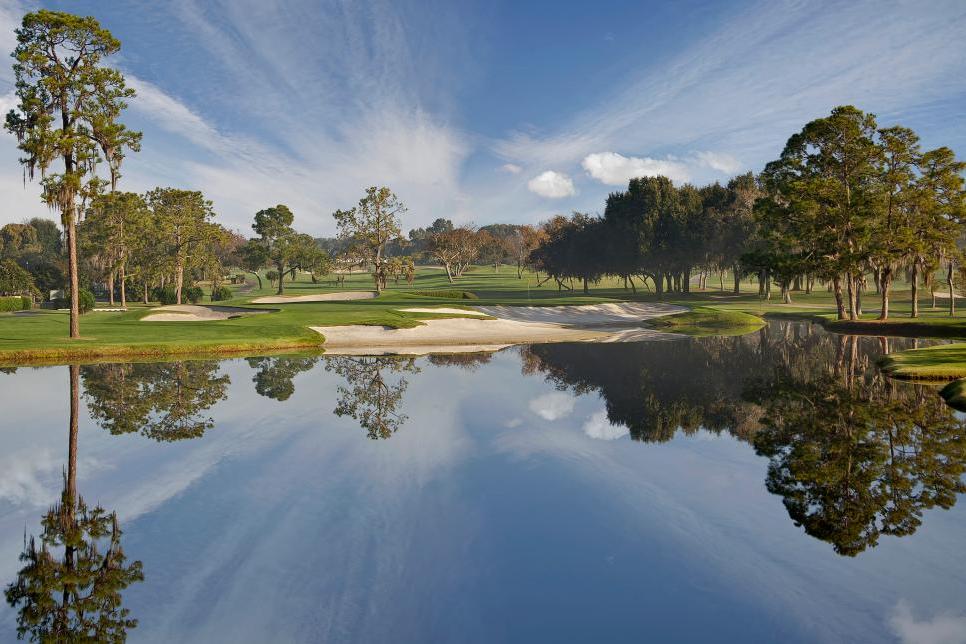
Stay at the Bay Hill Club and Lodge and you can play the Champion and Challenger nines, which annually host the Arnold Palmer Invitational. Just as it does for the pros, Bay Hill will offer a stern test, with strategically placed bunkers, deep rough, and imposing lakes all lurking.
After playing where the best players in the world compete, head 15 miles west to Orange County National, where players have forged their path to the PGA Tour at this longtime Q-school host. The Panther Lake course winds through rolling meadows, native pines, and wetlands, immersing golfers in the natural landscape. Elevation changes of up to 60 feet and no housing developments make this Florida course unique. Crooked Cat, often considered easier than its sibling course, offers more of a links-style experience, with native heather framing the wide fairways.
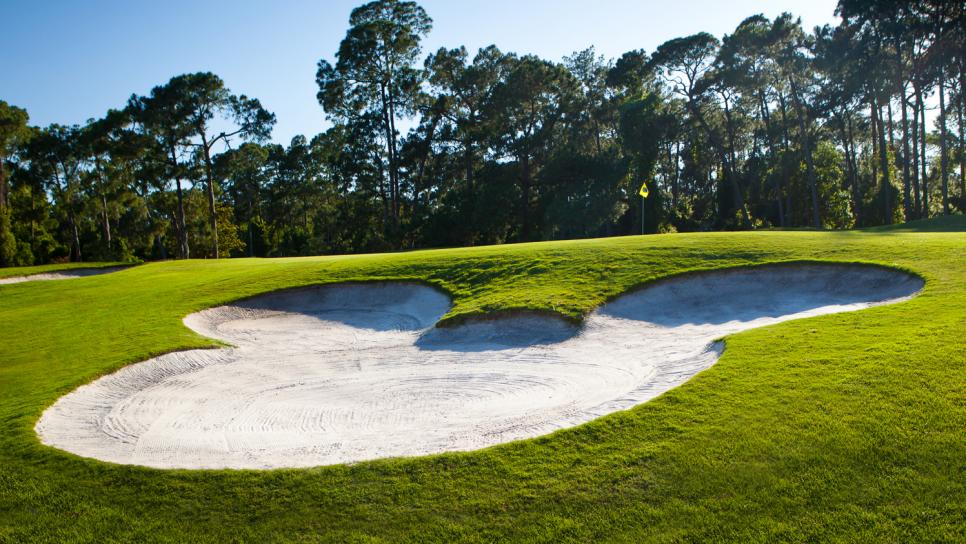
A trip to Orlando wouldn’t be complete without a visit to the Disney area, where you’ll find the Magnolia Course (above), which hosted a PGA Tour event for decades. Tiger Woods collected his second career PGA Tour title at this course which features wide fairways guarded by water, which lurks on 11 of the 18 holes.
Around 20-25 minutes south in Kissimmee are three courses at Reunion, a Golf Digest Editors’ Choice winner for Best Resorts. The Nicklaus Course, designed by Jack, is generally forgiving off the tee, but small, undulating greens place a premium on precise iron play. Elevated railroad-tie tees and greens, along with the occasional pot bunker, give the course character.
The Watson Course, designed by Tom Watson, utilizes strategic bunkering and hilly terrain as its defense. With hardly any water in play on the course, bunkers line the fairways, which are generally wide.

The Palmer Course (above) challenges players with undulating terrain, creating uneven lies in the fairways and rough. This Arnold Palmer-design features significant elevation changes, including a 50-foot drop from tee to green at the par-3 second.
Travel northwest from Orlando to Mission Hills Resort to play two courses which have hosted numerous amateur and professional events, including PGA Tour Latinoamerica Q-school last fall. The El Campeón course opened in 1917, making it one of the oldest courses in the area. The course is situated on steep hills with elevation changes of over 85 feet, and water is in play on most holes. The Las Colinas course has less water in play, but the large, undulating greens provide an intriguing test. Trees closely guard many fairways on the back nine, placing a premium on accuracy off the tee.
Interested in booking one of these trips? Click here to start pricing out your trip with our friends at Golfbreaks by PGA TOUR, or call them: (+1) 843.779.7134.
For those in search of combining a trip to the Caribbean with some golf, look no further than the Dominican Republic. With designs from some of golf’s most prominent architects, the DR is truly the heart of golf in the Caribbean.

Courtesy of Puntacana Resort & Club Images
The Westin Puntacana Resort & Club is a five-star property that boasts three miles of beach-front property, two restaurants, three bars and two golf courses on site.
La Cana, designed by P.B. Dye, features 27 holes, 14 of which have ocean views. In an effort to remain environmentally efficient, La Cana was the first course in the Caribbean to use paspalum grass, which can be watered with seawater.
In the lead up to the Masters, the PGA Tour stops at Corales Golf Club in late March. This Tom Fazio design hosted the first PGA Tour event in the Dominican Republic and features six oceanfront holes and a wicked three-hole conclusion, aptly named the “Devil’s Elbow.”
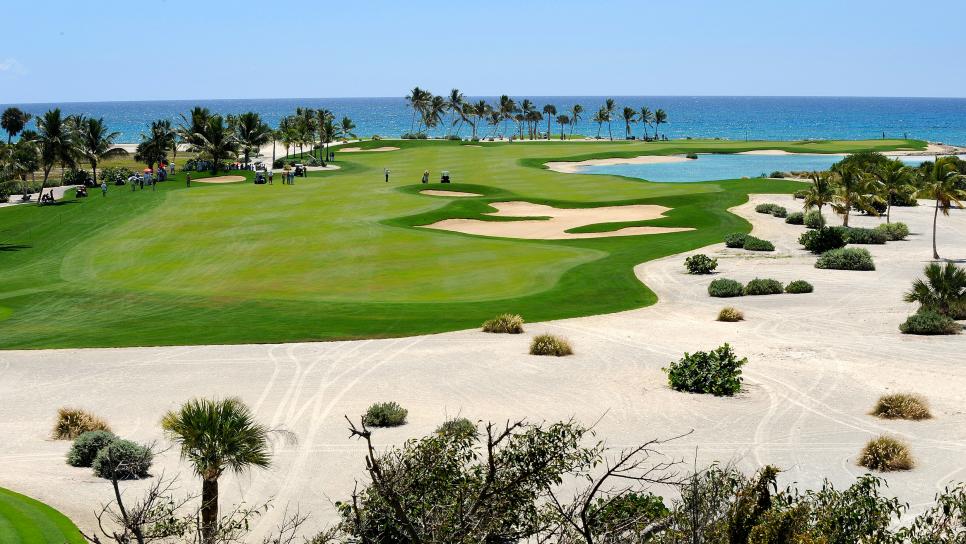
2010 Stan Badz/PGA TOUR
Punta Espada Golf Club (above) was designed by Jack Nicklaus and opened in 2006. The course makes excellent use of the coastal geography, with holes running along cliffs, beaches and lagoons. The PGA Tour Champions made three stops here from 2008 to 2010.

Enrique Berardi/LAAC
The Casa de Campo Resort (above) is widely regarded as one of the best destination golf resorts in the world. Three Pete Dye courses await guests, as do more than a dozen restaurants on the property. The Teeth of the Dog Course features seven holes that run along the Caribbean Sea, which prompted Dye to remark, “I created 11 holes and God created seven.” Featuring iconic par 3s, tricky doglegs and other signature Dye obstacles, Teeth of the Dog ranks No. 32 on Golf Digest’s World’s Greatest 100 Courses.
The most recent addition to the resort is the Dye Fore course. Each of the three nine-hole loops offers something different: Chavón has five cliffside holes, Marina plays down the Chavón River with views of the Caribbean Sea and the aptly named Lagos loop plays around three huge lakes.
The Links course isn’t talked about as much as the other two, but offers similarly picturesque views and a stern test. It’s not very long, measuring under 6,800 yards from the back tees, but was renovated in 2012 to make it a bit more challenging for lower handicaps. Dye designed this course with the British Isles in mind, incorporating large rolling hills and many waste bunkers that will gobble up wayward tee shots.
Interested in booking one of these trips? Click here to start pricing out your trip with our friends at Golfbreaks by PGA TOUR, or call them: (+1) 843.779.7134.
